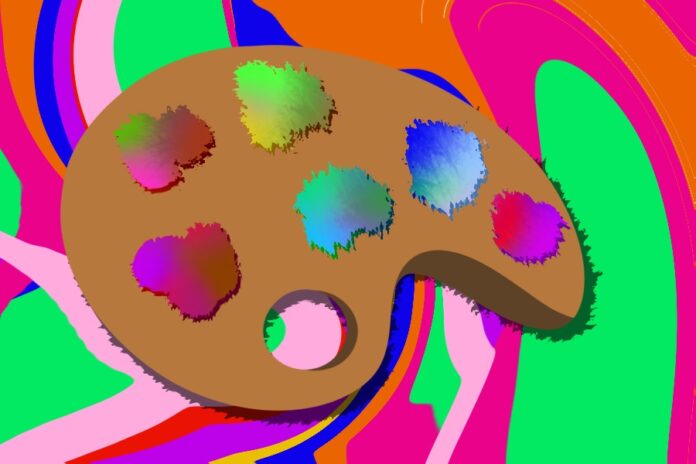LSD moves the visionary art movement
Alex Grey is considered an American visionary artist. He paints images to illustrate the transcendency of body, mind and soul by means of spiritual and mystical themes. A world renowned painter, author, teacher and Vajrayana practitioner, Grey is revered as the main influencer of the visionary movement.
Hailing from a middle-class family in Columbus, Ohio, Grey’s father was a graphic designer who bolstered Grey’s fascination with art by supplying him with the resources to pursue his interests. After attending two art schools and a five-year vocation at Harvard Medical School where he worked in the Anatomy department studying cadavers in-line for dissection, Grey’s art is nearly unexplainable. His art takes shape as a psychedelic x-ray vision into body, highlighting the soul and mind in connection with “the light” at the end of the tunnel.
One of his most famous works, “Cosmic Christ,” is a 50 by 102-inch oil painting on carved wood. It’s a burning inferno outlining the image of Christ, and within the outline is a series of micro-paintings that depict a wide range of historical figures and events, some of them mythical.
Something wholly unique to Grey’s style is that his paintings confront the realities that surround us and the sources of light and dark within us. Much like “Cosmic Christ,” his countless works show corporeal bodies with their brainwaves and energies illustrated towards a higher power — toward a light. His paintings always have a light in the top corner or center. Is this light God, the universe or the “clear light?” As interpreted by Timothy Leary, a psychedelic visionary of the 1960s, it may represent the subtlest level of the mind — a Buddha-like nature.
Artwork such as Grey’s does not take place in a vacuum. We can attribute his immeasurable skills to his time spent studying at Columbus College of Art and Design, where he subsequently dropped out to pursue a career in painting. His skills can also be attributed to his time at the School of the Museum of Fine Arts, Boston, where he studied under conceptual artist Jay Jaroslav. But his art shifted with his spirit when he began to use LSD, or acid.
For roughly five years, he and his partner Allyson Grey, also a psychedelic artist, indulged in sacramental journeys on LSD that, according to Grey, transformed his agnostic existentialism to radical transcendentalism. As the story goes, the two lovers shared a spiritual experience that is entirely unexplainable by earthly logic. This experience would drive Grey to produce pious artwork that would become revered world-wide, driving bands such as Tool to commission him to create their album covers. In addition, The Chapel of the Sacred Mirrors, a New York church, was constructed to house their sacred paintings.
Besides painting multidimensional situations and detailed representations of the human body with its chakras, auras and other spiritual tessellations, Grey has contributed to the world of philosophy through his 1998 book “The Mission of Art.” In his ledger, he promoted the mystical potentialities of art, saying “the process of artistic creation can (and should) play a role in the enlightenment of the artist […] the process of artistic creation holds the potential of transcending the limitations of the mind and more fully expressing the divine spirit.”
Grey is in touch with an inner divine spirit that can only be attributed to his five-year journey through the depths of his mind by way of psychedelic drugs. And he is not alone on this divine plane. Now resting somewhere in the void, Salvador Dalí and Hieronymus Bosch had their experiences with psychedelics, which influenced the dreamscapes of their paintings.
However, Grey’s paintings focus less on dreamlike landscapes and more on the divine spirit of the human soul and its interconnectedness with the light above and within. As a supporter of the psychedelic experience, Grey now hosts lectures on psychedelic therapy in New York with Dr. Anthony Bossis and full moon gatherings at his chapel.
His chapel gatherings revolve around guided meditations, lectures and art classes and provide information for its visitors to go out and seek psychedelic therapy on their own.
The Chapel of the Sacred Mirrors also features a number of modern artists who illustrate the same hallucinogenic visions in their art. From Jonathan Solter, who paints ancient pyramids in a field of colorful rays which he calls “The Halls of Creation” to Nadia Satya, who paints the beauty of circles — that is, what one might see thirty minutes into a double dose of LSD.
Grey paved the way for modern visionary art through his experiences with psychedelics. By constructing the chapel, physically and digitally, he provides an outlet for other visionary artists to promote their paintings and he intends to expand this spiritual community through his lectures and classes.
Furthermore, he plans to create a social space in upstate New York: the Entheon. It will be a 12,000-square foot exhibition built to house the original artwork of the Visionary Art movement. According to the chapel’s website, it will be a place “where precious paintings, drawings, sculpture and moving image resonate with the highest states of consciousness.” For $150, visitors can lay a brick at the Entheon with a personal message inscribed.
Written By: Clay Allen Rogers — arts@theaggie.org




